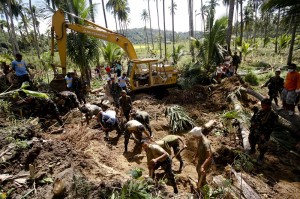LA LIBERTAD, Negros Oriental—Tayasan, Jimalalud and La Libertad have turned into virtual ghost towns as people refuse to go back to their homes in the coastal villages, shaken by continued aftershocks four days after a strong earthquake struck the province.
Despite assurances of safety from authorities, many prefer to stay on higher ground.
Stores and public markets have remained closed since Monday. The power supply has yet to be restored, while gasoline fuel are peddled in soda bottles.
“There’s nothing to buy, nothing to eat and nothing to drink,” a journalist assigned to cover events following the earthquake told the Philippine Daily Inquirer.
The 6.9-magnitude earthquake failed to topple buildings when it occurred at 11:49 a.m. on Monday. But it was the second major aftershock at 6:10 p.m., measuring magnitude 6.2, that caused the collapse of many structures.
“The aftershocks are scary. We survived the first one but the succeeding ones may be stronger,” said Maria Bartolome, a market vendor.
Stores closed
Representative Josy Limkaichong of Negros Oriental’s first congressional district, which includes Tayasan, Jimalalud, La Libertad and Guihulngan City, appealed to businessmen to open their stores in order to help address the evacuees’ needs.
La Libertad Vice Mayor Emmanuel Iway and Guihulngan Mayor Ernesto Reyes appealed for food and water supplies for their constituents.
Both officials said that although they were grateful for the relief goods and potable water coming from concerned sectors and individuals, these were not enough.
“We are getting a lot of help, but we don’t know how long this will last,” Reyes said.
Food, water needs
Lines in the distribution of relief goods were two kilometers long, Padilla said.
Some people, he said, had gone to Barangay (village) Poblacion from the hills where they stayed after the earthquake, hoping to get some relief goods.
Reyes said the immediate needs were food and water, while the repair of infrastructure facilities in the city, although necessary, would take time.
Women and men, children and elderly people lined up along the national highway in Guihulngan with empty water containers appealing for help.
Their message was clearly written in cardboard, wooden and paper signs in the Visayan dialect: “SOS: pagkaon kag tubig (food and water).”
Fire trucks from cities and towns in the neighboring province of Negros Occidental brought water but many more came with empty containers.
Reyes said people had nowhere to go to buy food since the stores in his town remain closed. Some opened to get supplies apparently for their own consumption but were swamped by buyers.
Runaway prices
In Guihulngan, two stalls outside the collapsed public markets opened for a few hours on Wednesday and managed to sell rice, sardines and some basic commodities. Their supplies ran out even if these were sold at exorbitant prices.
Some were selling gasoline in soda bottles at P100 per liter. The fuel was reportedly bought from a station in Canlaon City and resold in Guihulngan.
“But the people didn’t mind because at least they had gasoline to buy,” said James Padilla, a teacher at Guihulngan National High School.
Three water purifying machines from the National Development Command of the Armed Forces of the Philippines began to operate on Thursday to help provide potable water.
There has been a severe water shortage after the quake destroyed water pipes and disrupted supply even in artesian wells.
Guihulngan has been experiencing complete power outage, while La Libertad, Canlaon and Vallahermoso town only have 30 percent of power supply, said Leo Acabal, general manager of the Negros Oriental Electric Cooperative (Noreco I).
Acabal said he was waiting for the National Grid Corp. of the Philippines to repair its transmission tower, which connects the geothermal plant in Palinpinon town to the distribution line in Guihulngan.
He said he hoped all power lines would be restored Friday.
